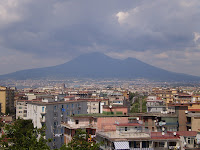







(Pictures: Fresco at the Villa San Marco as well as the courtyard, kitchen, atrium, and a hole through a wall. A pear fresco and room of the Villa Arianna as well as the view of Mt. Vesuvius on the opposite side.)
In un mondo di ciechi un orbo e re.
(In a world of blind people, a one-eyed man is king.)
Nook of Naples: Driving through small streets, I go in circles for a while, passing town centers where vendors sell pizza and cafe. I finally find a long narrow road with signs and stop at an empty parking lot with a trailer wedged to the left of a gravel road. A guide takes me along this road and I expect to see a run down lot with a rubble of unrecognizable ruins. Instead, he brings me to the edge of a stunning edifice perched over a dramatic view of Naples.
The Villa of Arianna, so named for a fresco of Dionysus and Adriadne inside, stretches along a walkway overlooking the city. As I wander through room after room it becomes clear that this villa was once flush with deep colored frescoes on every wall, detailed mosaics on every floor, and a complicated maze of rooms.
Once a popular resort area for wealthy Romans, Pliny the Elder wrote that several miles of luxury villas existed here. Pliny died in Stabia after setting sail across the Bay to rescue people during the 79 AD eruption, but succumbed to the deadly ash himself. Stabia was destroyed by more than ten feet of tephra ash.
Today, only two villas are open to the public. Down the road from Villa of Arianna, the much better preserved Villa San Marco measures more than 11,0000 meters. A stroll through this structure means seeing a well-preserved atrium, triclinium, and kitchen. The villa also once had an extensive bath system, including a caldarium, tepidarium, and frigidarium.
Getting There: Villa San Marco – Ufficio Scavi di Stabiae -- Via Passeggiata Archeologica -- Castellammare di Stabia (Napoli)
La Cucina Napoletana: The ancient Roman Columella (AD 4 - ca. AD 70) had a career in the army after which he took up farming. He wrote De Re Rustica in twelve volumes, a work that has been completely preserved. Here he writes about a cheese appetizer: "Delicious particularly when it is very soft. With all the herbs that are in season, after having cleaned them well, skin and crush the larger walnuts all in the quantity you consider opportune,then combine well (with the cheese). Season with a little vinegar and pepper and cover with oil."
Here is Eugenia Salza Prina Ricotti's version from Ricette Della Cucina Romana A Pompeii:
Walnut Cheese
150 g herb cheese (cream cheese, ricotta, mascarpone with herbs already inside)
50 g shelled walnuts
Add the shelled and crushed walnuts to the herb cheese and blend together. Make sure the mixture doesn't become hard and dry. Because the walnuts have the gift of absorbing oil, the desirable consistency of the cheese can be soft and creamy. To get this consistency, little by little add small quantities of oil until you bring the mixture to the consistency of ricotta or mascarpone. Finally, season with a little vinegar and pepper, tasting to repair the flavor with salt and vinegar as needed. This dish conserves well for long periods of time as long as it's kept in the refrigerator and covered in oil.
2 comments:
Love the blog. I never knew these wonderful places where nearby. Have you ever thought about opening your own english speaking tour company? Stellina in Castel San Lorenzo
Thanks, Stellina. A tour company would probably be more work than I have time for with three small children at home. But I'm glad you like the blog. I'm working on the "Naples Underground Tour" and "The Odious Women's Tour," so hope you'll keep coming back. Un caro abbracio! Barbara
Post a Comment